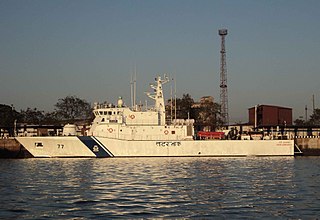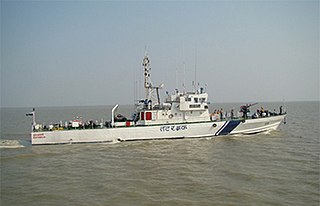Related Research Articles

The Long Range Interceptor (LRI) is an 11-meter high speed launch vessel designed to be deployed from United States Coast Guard cutters via a rear launching ramp. The Long Range Interceptor is an aluminum boat, powered by Ultrajet brand water-jets, for intercepting and boarding suspect vessels. It mounts a radar, special shock-proof seats, and can travel at 35 knots (65 km/h). They can be armed with machine guns or grenade launchers, and can be equipped with ballistic panels for crew protection when required.

Garden Reach Shipbuilders & Engineers Ltd, abbreviated as GRSE, is one of India's leading shipyards, located in Kolkata. It builds and repairs commercial and naval vessels. GRSE also exports the ships that the company builds.
A rescue lifeboat is a boat rescue craft which is used to attend a vessel in distress, or its survivors, to rescue crew and passengers. It can be hand pulled, sail powered or powered by an engine. Lifeboats may be rigid, inflatable or rigid-inflatable combination-hulled vessels.

BRP Alberto Navarrete (PC-394) is the lead ship of the Alberto Navarrete-class of Coastal Patrol Craft of the Philippine Navy.

ABG fast interceptor craft are a series of thirteen 26-metre (85 ft) high-speed interceptor boats designed and supplied in knocked down kits by Henderson based Global Marine Design and assembled by ABG Shipyard, Surat for the Indian Coast Guard.

The Rani Abbakka-class patrol vessel are a series of inshore patrol vessels being built by Hindustan Shipyard Ltd. for the Indian Coast Guard. They are based on Australian Thornycroft design. The ship, incidentally, is named after Abbakka Mahadevi, the legendary queen of Tulunadu, Karnataka who fought the Portuguese in the latter half of the 16th Century.
GSL/GRSE series of Interceptor Boats are Indian high speed patrol boats assembled by Garden Reach Shipbuilders & Engineers Limited (GRSE), Kolkata and Goa Shipyard Limited (GSL), Goa.

Sarojini Naidu Class Fast Patrol Vessels are series of seven Mid Shore Patrol Vessels built by Goa Shipyard Limited at Vasco da Gama, Goa for the Indian Coast Guard produced between 2002 and 2006.

Priyadarshini-class patrol vessels are a series of 8 mid-shore fast patrol boats, built by Garden Reach Shipbuilders & Engineers, Kolkata and Goa Shipyard Limited, Vasco da Gama, Goa for Indian Coast Guard between 1991 and 1998.
Swallow Craft Class of Inshore Patrol Vessels are a series of watercraft built by South Korea's Kangnam/Swallow Craft, in Pusan for the Indian Coast Guard.
AMPL (P-2000) class of interceptor boats are series of ten watercraft built by M/s Anderson Marine Private Limited, Goa, India for the Indian Coast Guard.
Mandovani Marine (12.5-Meter) class of patrol crafts are a series of five watercraft built by Mandovi Marine Pvt LTD, Indore for Indian Coast Guard during the 1980s .
The Bristol class of interceptor craft are a series of watercraft built by Bristol Boats, a division of Chika Pvt. Ltd Aroor, for the Indian Coast Guard. These boats are intended for carrying out patrol duties in shallow water areas near the coastline. The contract was signed on 22 March 2004 for acquisition of eight Interceptor Boats by the Indian Coast Guard at a total cost of Rs 3.74 crores. The first craft became operational on 1 December 2004.
The Timblo class interceptor craft is a class of ten vessels built by Timblo Drydocks Pvt. Ltd, Goa for the Indian Coast Guard.
Praga class of patrol boats are series of five Rigid-hulled inflatable boat built by M/s Praga Marine, India for National Coast Guard (NSG) organisation, Mauritius and are also referred as Heavy Duty Boat (HDB). They are intended for patrol, interception and search and rescue operations.
GRSE Mauritius offshore patrol vessel (MOPV) is a corvette being built by Garden Reach Shipbuilders and Engineers (GRSE), Kolkata, for the National Coast Guard of Mauritius.
Timblo-class patrol crafts are a series of patrol workboat built by Timblo Drydocks Private Limited, Goa.

The Swift-class coastal patrol craft were a series of patrol vessels built for the Republic of Singapore Navy (RSN) by the Singapore Ship Building and Engineering Company (SBEC).

Jehu-class landing craft are a class of military transport vessels used by the Finnish Navy. Manufactured by Marine Alutech under the designation Watercat M18 AMC, the boats can perform a multitude of tasks ranging from troop transport and landing operations to patrolling and escort tasks as well as combat and battle support operations. The Jehu-class boats are considerably larger and better armed that the preceding Jurmo-class landing craft.